In Minneapolis, nothing stops bicyclists — not even winter
MINNEAPOLIS — There was a healthy bite to the morning air, with the mid-March temperatures stuck in the high-30s, but the two weather-tested bicyclists were unfazed, as though striking out on a leisurely Fourth of July ride.
Dorian Grilley and road partner Nick Mason pedaled along residential side streets still ice-choked from a long winter’s pounding. Grilley, 56, rode an old mountain bike with fenders and metal-studded tires. He eased through less-slippery rivulets of melted ice, his back tire throwing up a rooster tail of water, sand and road salt.
Leading the way on his “fat bike,” a cartoonish-looking contraption with 4-inch-wide tires designed to roll over snow, the 34-year-old Mason hotdogged out in front; jumping curbs, surging over mounds of street ice, his bike moving with the rumbling determination of a monster truck.
One week earlier, temperatures had plummeted to a teeth-chattering 11 below zero. “It was 50 degrees colder than today, with a killer wind-chill,” Mason said. “Man, that was fun.”
Minneapolis and Portland, Ore., are considered the nation’s two bike-friendliest cities, but here in the Land of Perpetual Snow and Ice, bicycles roll even when winter brings to mind glacial Siberia.
Each January, when the average low temperature here is just 7 degrees above zero, biking advocates sponsor the Stupor Bowl, held on the same day as the NFL title game. The event is an eclectic mix of Alaska’s Iditarod and Nevada’s Burning Man festival, where hundreds of entrants compete along a frigid ice-encrusted course in categories for both the hard-drinking and the sober.
In Minneapolis, snow and cold are considered a nuisance, not a barrier. After most snowstorms, officials plow the city’s two major arterial bike trails and bike boulevards — residential streets set aside for bicycles — at the same time they clear major car thoroughfares. Women’s groups here offer free access to shops where riders fine-tune their bikes and wipe down the rust-inducing road grit. Each November brings seminars where veteran cyclists advise more novice riders on how to survive winter.
In 2010, Minneapolis started the nation’s first large-scale bike sharing system, and it boasts one of the finest networks of off-street bicycle trails in the U.S. The Twin Cities of Minneapolis and St. Paul also received $28 million as part of a federal pilot project to expand the cycling culture, which advocates here say has seen a phenomenal rise.
Between 2007 and 2013, the number of regular bikes rose 78%, according to data collected at various checkpoints throughout the city. Among the city’s 400,000 residents, 20,000 bike-commute during the summer and as many as 7,000 do so year-round, Grilley said.
Mayor Betsy Hodges declared Jan. 3 Winter Biking Day in Minneapolis. That morning, following an overnight low of minus-10, she boasted of the locals: “Minneapolis winter bicyclists, like Minnesotans in general, are more resilient, more hardy, more ‘Die Hard’ gritty, just plain tougher and much better looking than cyclists from all those wimpier cities.”
This winter tested the mettle of even the most dedicated riders. Blasts of Arctic air routinely sent temperatures below zero, with heavy snowfalls and biting winds. February brought a respite, but like a numbing sledgehammer, winter returned, flash-freezing melting snow into ice while adding another foot of new snow.
“Below zero, the salt doesn’t do its job fast enough,” said Grilley, executive director of Bicycle Alliance of Minnesota. “But riders were still out there.”
Though roads here are wider to accommodate collecting snow, winter poses both a physical and emotional test. Long commutes mean riding in the darkness. Wear and tear on their equipment is so daunting, most riders have several bikes and rarely use their best ones for the coldest, saltiest months.
But some people love it. Laura Kling commutes 20 miles a day to her job as a state research analyst. The cycling advocate recently wrote a blog for the advocacy group greaserag.org on 28 things she liked about winter riding — one for each day of February.
She wrote about the serious grip of metal-studded tires, the solitude of a long cold ride, and how a winter tail wind is like “the universe giving you a little boost.” To Kling, there’s no such thing as bad weather, only bad attitudes. “Once you realize the hardest part of winter riding is getting out the door in the morning, you’ll be a success,” she said.
At times, winter is her favorite season: “I love the morning quiet when the roads are just plowed but there’s still no traffic and the nights when the fluffy flakes are falling slowly and I can hear my tires crunching over the snow,” Kling wrote. “It’s like riding in a snow globe.”
Grilley remembers the infancy days of winter biking here in the early 1980s, when he had to fashion his own studded tires with tiny screws and duct tape.
Still, the onetime amateur road racer became convinced two wheels were better than four, even in winter. “Plows stranded motorists in their driveways; they had to dig themselves out,” he said. “My bike always starts and never gets stuck.”
Gene Oberpriller, who cofounded the Stupor Bowl, says each winter day brings a new biking challenge: “I get up in the morning and say, ‘How are you going to try and top me today?’ We talk about Ernest Shackleton, the polar explorer. If he could do that, this is easy.”
In 2009, Oberpriller and some buddies competed in the Snowball’s Chance in Hell Ice Derby, riding their bikes across frozen Brownie Lake. The weather turned ugly, with the temperature dropping 30 degrees, and the group hurried back to Minneapolis: “I worried about frostbite that day.”
Today, winter biking is a way of life here. At Quality Bike Products in Bloomington, outside Minneapolis, 200 of the company’s 500 employees commute daily to work — last year totaling 320,000 road miles. The top rider logged 9,384 miles, an average of 36 a day, and the firm found that such avid cycling made employees healthier and cut medical costs.
That fact inspires Grilley and Mason as they pedal across wintry Minneapolis.
With his super-wide tires, which are kept at low pressure, Mason had a feeling of floating over the snow, like riding a beach bike with more muscle and durability.
They cruised a bike boulevard where cars are discouraged, their studded tires humming on the asphalt, then swooped down onto the Midtown Greenway, a 5.5-mile-long bike freeway set along a former railroad corridor where, at some intersections, cars must give way to cyclists.
Later, they stopped at a bike store with its own coffee shop. Sweaty, they peeled off layers of clothes, knowing that while spring has nearly arrived — bringing warmer temperatures elsewhere — snow can hit Minnesota even in April. They know the chances are good they’ll give winter yet another run. The Friday forecast calls for snow.
More to Read
Start your day right
Sign up for Essential California for news, features and recommendations from the L.A. Times and beyond in your inbox six days a week.
You may occasionally receive promotional content from the Los Angeles Times.






